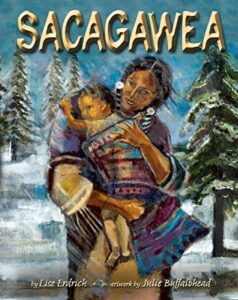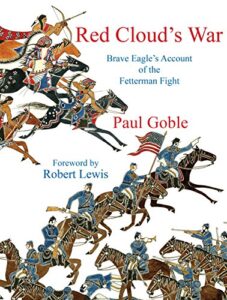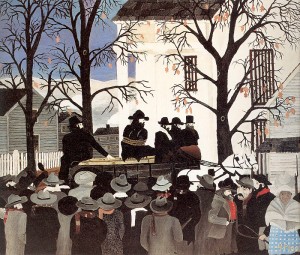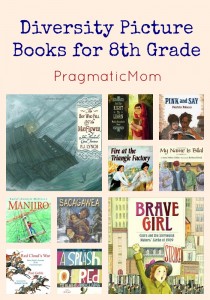PickyKidPix is now in 8th grade but only less than halfway through. She tells me that her curriculum covers Colonial America, the Industrial Revolution in science, American Revolution, Civil War, the French and Indian War, Constitution, and Racism.
I’m creating multicultural picture book lists for middle school in hopes of helping teachers cover their curriculum. I hope that they will participate in the Multicultural Children’s Book Day’s Classroom Reading Challenge. They can earn a FREE hardcover diversity book provided by reading four picture books during the month of January. Sign up here.
What books should I add to this list? Thanks for your help!
p.s. Here are all the books in this series:
- Diversity Picture Books for 4th Grade
- Diversity Picture Books for 5th Grade
- Diversity Picture Books for 6th Grade
- Diversity Picture Books for 7th Grade
- Diversity Picture Books for 8th Grade
Colonial America Picture Book for 8th Grade
The Boy Who Fell Off the Mayflower or John Howland’s Good Fortune by P. J. Lynch
P. J. Lynch’s masterful watercolor paintings and vivid prose told from the perspective of young John Howland bring to life the difficulties of the Mayflower settlers. John is an indentured servant and his master and mistress seek religious freedom in the New World. His adventure begins with certain death should he be caught before boarding the Mayflower. Once aboard, the voyage is plagued with misfortune. John gets cast out to sea when a big wave hits the desk and survives miraculously because a rope trailed behind the ship. Life in the New World is not easier. Only half of the pilgrims survive the brutal New England winter but the local Native Americans, the Wampanoag, prove to be their saviors. When John Howland’s Mistress and Master die, he is freed of his indentured servitude. Should he stay in this new world or return home? [advanced picture book, ages 8 and up]
Squanto, 1585?-1622 by Arlene B. Hirschfelder
Squanto was a member of the Patuxet tribe, which was part of the Wampanoag Confederacy. They made their home in what is today Massachusetts and Maine.
Squanto learned English as the result of being kidnapped by Englishman Thomas Hunt who hoped to sell native men as slaves in Spain. He was able to take the men to Spain but was thwarted by local priests who rescued Squanto and others. Squanto then went on to live in England with Sir Fernando Georges who owned what is today Maine. Squanto learned some English during his stay and he made his way back to Patuxet a few years later with exploring Thomas Dermer.
The Patuxet people, Squanto learns, have been wiped out by disease. While living with Massasoit, Squanto helps to negotiate a peace treaty with the Mayflower settlers and helps them survive by teaching them how to plant crops and to forage for food.
Today, many Wampanoag do not agree with Squanto’s popular role as a friend of the English. They believe that he became more interested in personal power than in helping his own people. Or could Squanto be a victim of Stockholm syndrome? [biography picture book, ages 8 and up]
Lewis and Clark Expedition
Sacagawea by Lise Erdrich, illustrations by Julie Buffalohead
At 11 or 12 years of age, a young Shoshone girl was abducted by Hidatsa warriors during a horse raid in what is now Montana. They gave her the name Sacagawea or “Bird Woman.” When she was no more than 16, she was given in marriage to Toussaint Charbonneau, a French Canadian fur trapper, as his second wife. Charbonneau proposed to Lewis and Clark that they hire him as a guide and interpreter for the Corps of Discovery, a group of more than forty men, instructed by President Jefferson to travel from Mississippi to the Pacific primarily by boat. Right before the expedition began, Sacagawea gave birth to their son, Pompy.
When the Corps reached Sacagawea’s former home in what is now Montana, she was amazed to discover that the Shoshone chief was her brother, Cameahwait! The Shoshones provided necessary horses for the next difficult leg of their journey, eventually making it all the way to the Pacific Ocean.
Sacagawea was instrumental to the success of the expedition. With a baby as part of the party, their group did no appear menacing. Sacagawea’s skills in foraging for food, guiding the men through the wilderness and negotiating with the Shoshone might have been the difference between success and failure. Her story is beautifully and fittingly told by Lisa Erdirch and Julie Buffalohead who are also Native American.
Civil War Picture Books for 8th Grade
Pink and Say by Patricia Polacco
Patricia Polacco’s great-great-grandfather, Sheldon Russell Curtis, was wounded in battle during the Civil War. Another wounded young man, Pinkus Aylee, also from the Union army found him and carried him back to his childhood home where his mother had stayed behind, despite the danger of marauders all around. His mother is murdered trying to protect them, and soon after, they are captured by the Confederate army. Pinkus is hanged hours after he was taken to a Confederate war camp; Sheldon is released a few months later, weighing no more than seventy-eight pounds.
Approximately 620,000 soldiers died from combat, accident, starvation, and disease during the Civil War — more than twice the total US dead in Vietnam — and possibly undercounted. It was the bloodiest, most devastating conflict in American history and the human toll is illuminated here in this advanced picture book by Polacco’s own family history. [picture book, ages 10 and up]
Red Cloud’s War: Brave Heart’s Account of the Fetterman Fight December 21, 1866, by Paul Goble
Red Cloud’s War is the only instance in the history of the United States where the government had gone to war and afterwards negotiated a peace treaty conceding everything demanded by the enemy and exacting nothing in return. Doane Robinson, State Historian of South Dakota
After the Civil War ended, the fastest passage to the gold rush territory of Montana is through the Bozeman Trail but dangerous because it passes through the lands controlled by the Oglala Lakota. This is an account through the eyes of a young Lakota warrior, Brave Eagle, during a time when the United States is nearing completion of driving the Indians from their land. Cognizant that when white men were allowed passage, it was only a matter of time before they claimed the land, Chief Red Cloud refused access to the Bozeman Trail. The U.S. government decided to build forts along the trail and war soon broke out. For the U.S. infantry, there were no survivors. [advanced picture book, ages 12 and up]
Industrial Revolution Picture Books for 8th Grade
Fire at the Triangle Factory by Holly Littlefield, illustrated by Mary O’Keefe Young
Minnie and Tessa are unlikely friends because it isn’t easy for an Italian American Catholic girl and a Jewish girl to be friends in 1911. But they are both fourteen-years-old sit side by side working as sewing operators in a factory with dangerous working conditions. When a big fire breaks out at the Triangle Shirtwaist Company, their friendship, and quick thinking save them from perishing in the deadliest industrial disaster in the history of New York City. [early chapter book, ages 6 and up]
Brave Girl: Clara and the Shirtwaist Makers’ Strike of 1909 by Michelle Markel, illustrated by Melissa Sweet
Clara Lemlich, an immigrant from Russia, led the largest walkout of female workers in the country’s history to protest hazardous working conditions. Despite the danger, Clara’s protests put her in, she doesn’t back down. She’s arrested sixteen times and six of her ribs are broken. The Triangle Waist Factory fire happened in the middle of this maelstrom which claimed 146 lives. In the aftermath of the strike, Clara is successful in improving conditions for the women and young girls who work in New York’s garment industry and she spends the rest of her life fighting to improve the conditions of workers. [picture book, ages 6 and up]
World War I Picture Books for 8th Grade
A Splash of Red: The Life and Art of Horace Pippin by Jen Bryant, illustrated by Melissa Sweet
John Brown Going to His Hanging is an example of Pippin’s paintings that shows his interest in genre paintings and civil rights issues. Image from Wikipedia
Horace Pippin was an African-American self-taught artist who served in WWI. He joined the army and was badly wounded during the war. He was always drawing and painting but now, with his shoulder injury, he could not. Still, his grandmother’s stories of her slave days in Virginia and the images from his own life experiences made him long to make art. He tried with an iron poker on a piece of wood and slowly but surely, he rehabilitated his arm until he could paint again. It took many years before he became recognized as an artist, but now museums all over the US are proud to display his art. [biography picture book, ages 5 and up] *You can use this biography on Horace Pippin to also make connections to art history, African-American History Month, and the Civil Rights Movement.
Picture Books About Racism for 8th Grade
My Name is Bilal by Asma Mobin-Uddin, illustrated by Barbara Kiwak
It isn’t easy being different at school. Bilal and his sister Ayesha are born in America and they have switched schools to a new school where there are not a lot of Muslim kids. Ayesha is bullied on her first day of school by two boys who make fun of her headscarf. Bilal is frozen, unable to come to his sister’s aid. This teacher is a family friend, and he gives Bilal a book about another Bilal was born in the time of Prophet Muhammed. This Bilal was also tormented by bullies who tried to get him to denounce his god but he would not. This new-found knowledge gives Bilal strength to stand up for his sister the next day when the bullies harass her at her locker. Bilal finds a way to connect with the bullies on the basketball court and it’s there he also meets an older boy who’s also Muslim. Now Bilal can call them both to prayer, just like the Bilal of olden times.
Muslim-American kids will surely be able to relate to this story and those who are not can develop empathy for what it is like being different by reading this book. [picture book, ages 6 and up]
Inspirational Picture Books for 8th Grade
Manjiro by Emily Arnold McCully
The true story of Manjiro, just 14 years old when his fishing boat is caught in a storm and shipwrecked on a small island. He and his companions are rescued by an American whaling ship, the John Howland*, and Manjiro ends up in New Bedford, Massachusetts. The year is 1841 and slavery exists in the United States. Manjiro attends school and learns English despite facing racism. He studies navigation at Bartlett’s Academy and works tirelessly on a quest to fund a voyage back to Japan, though this might mean certain death since Japan is closed to the outside world by decree of the Emperor. Manjiro makes his way to San Fransisco as part of the Gold Rush and raises the money to buy a small whaleboat, eventually making it back to Japan where he is reunited with his mother. [advanced picture book, ages 8 and up] *Did you catch the connection to John Howland from Manjiro to the John Howland who fell off the Mayflower?!
For the Right to Learn: Malala Yousafzai’s Story by Rebecca Langston-George, illustrated by Janna Bock
At just 11 years old Malala volunteered for the dangerous job of blogging about school closings in Pakistan due to the Taliban control. She was determined to pursue education even though it meant risking her life. Taliban leaders threatened her, putting her on their hit list. When riding the bus home one day, she is shot in the head. Eventually, Malala is flown to a hospital in Birmingham, England where she now lives and continues to fight for education for every boy and girl in the world. [picture book, ages 8 and up]
To examine any book more closely at Amazon, please click on image of book.
As an Amazon Associate, I earn from qualifying purchases.
p.s. Related posts:
Diversity Picture Books for 4th Grade
Diversity Picture Books for 5th Grade
Diversity Picture Books for 6th Grade
Diversity Picture Books for 7th Grade
50 MUST READ Diversity Picture Books
Big Book Format Diversity Picture Books for Storytime
12 Amazing NEW Diversity Picture Books
3 Amazing Wordless Diversity Picture Books
Follow PragmaticMom’s board Multicultural Books for Kids on Pinterest.
Follow PragmaticMom’s board Children’s Book Activities on Pinterest.
BEST #OWNVOICES CHILDREN’S BOOKS: My Favorite Diversity Books for Kids Ages 1-12 is a book that I created to highlight books written by authors who share the same marginalized identity as the characters in their books.




















I have a number of your choices and I think they are great for 8th graders. Like the historical fiction the most.
Can’t open your recent post on chapter books.
Hi Patricia,
I love historical fiction through picture books too and there isn’t enough of that for 8th grade!
I need to keep these in mind for when my kids are a little bit older.
Hi MaryAnne,
I’m not sure if 8th grade teachers will use these books but it was fun making this list. My 8th grade daughter helped me with the curriculum she had in middle school. She’s good at remembering that kind of stuff.